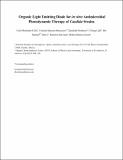Organic light emitting diode for in vitro antimicrobial photodynamic therapy of Candida strains
Abstract
Organic light emitting diodes (OLEDs) are very attractive light sources because they are large area emitters and, can in principle, deposited on flexible substrates. These features make them suitable for ambulatory photodynamic therapy (PDT), in fact there are a few reports of in vitro or in vivo OLED based PDT studies for cancer or microbial inhibition but to our best knowledge, none against yeasts. Yeast infections are a significant health risk, especially in low income countries with limited medical facilities. In this work, OLED-based antimicrobial PDT (aPDT), using methylene blue (MB) as photosensitizer (PS), is studied to inactivate opportunistic yeast of four Candida strains of two species: Candida albicans and Candida tropicalis. Before aPDT experiments, fluconazole-resistance was evaluated for all strains, showing that both strains of C. tropicalis were resistant and both strains of C. albicans were sensitive to it. We found that is useful for aPDT and that 3 repetitive irradiations work better than a single dose while keeping the total fluence constant, and that this result applies whether or not the strains are resistant to fluconazole.
Citation
Melendez-Celis , U , Spezzia-Mazzocco , T , Persheyev , S , Lian , C , Samuel , I D W , Ramirez-San Juan , J & Ramos-Garcia , R 2021 , ' Organic light emitting diode for in vitro antimicrobial photodynamic therapy of Candida strains ' , Photodiagnosis and Photodynamic Therapy , vol. In Press , 102567 . https://doi.org/10.1016/j.pdpdt.2021.102567
Publication
Photodiagnosis and Photodynamic Therapy
Status
Peer reviewed
ISSN
1572-1000Type
Journal article
Description
Funding: NSF grant 1545852 (OISE:PIRE-SOMBRERO)/CONACyT 251992.Collections
Items in the St Andrews Research Repository are protected by copyright, with all rights reserved, unless otherwise indicated.

